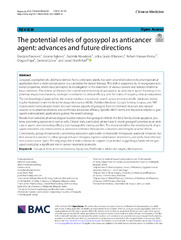Приказ основних података о документу
The potential roles of gossypol as anticancer agent: advances and future directions
| dc.creator | Paunović, Danijela | |
| dc.creator | Rajković, Jovana | |
| dc.creator | Novaković, Radmila | |
| dc.creator | Grujić-Milanović, Jelica | |
| dc.creator | Mekky, Reham Hassan | |
| dc.creator | Popa, Dragos | |
| dc.creator | Calina, Daniela | |
| dc.creator | Sharifi-Rad, Javad | |
| dc.date.accessioned | 2023-12-17T21:05:03Z | |
| dc.date.available | 2023-12-17T21:05:03Z | |
| dc.date.issued | 2023 | |
| dc.identifier.issn | 1749-8546 | |
| dc.identifier.uri | http://rimi.imi.bg.ac.rs/handle/123456789/1387 | |
| dc.description.abstract | Gossypol, a polyphenolic aldehyde derived from cottonseed plants, has seen a transformation in its pharmaceutical application from a male contraceptive to a candidate for cancer therapy. This shift is supported by its recognized antitumor properties, which have prompted its investigation in the treatment of various cancers and related inflammatory conditions. This review synthesizes the current understanding of gossypol as an anticancer agent, focusing on its pharmacological mechanisms, strategies to enhance its clinical efficacy, and the status of ongoing clinical evaluations. The methodological approach to this review involved a systematic search across several scientific databases including the National Center for Biotechnology Information (NCBI), PubMed/MedLine, Google Scholar, Scopus, and TRIP. Studies were meticulously chosen to cover various aspects of gossypol, from its chemical structure and natural sources to its pharmacokinetics and confirmed anticancer efficacy. Specific MeSH terms and keywords related to gossypol’s antineoplastic applications guided the search strategy. Results from selected pharmacological studies indicate that gossypol inhibits the Bcl-2 family of anti-apoptotic proteins, promoting apoptosis in tumor cells. Clinical trials, particularly phase I and II, reveal gossypol’s promise as an anticancer agent, demonstrating efficacy and manageable toxicity profiles. The review identifies the development of gossypol derivatives and novel carriers as avenues to enhance therapeutic outcomes and mitigate adverse effects. Conclusively, gossypol represents a promising anticancer agent with considerable therapeutic potential. However, further research is needed to refine gossypol-based therapies, explore combination treatments, and verify their effectiveness across cancer types. The ongoing clinical trials continue to support its potential, suggesting a future where gossypol could play a significant role in cancer treatment protocols. | |
| dc.publisher | BioMed Central | |
| dc.rights | openAccess | |
| dc.rights.uri | https://creativecommons.org/licenses/by/4.0/ | |
| dc.source | Chinese Medicine | |
| dc.subject | Gossypol | |
| dc.subject | Anticancer mechanisms | |
| dc.subject | Apoptosis | |
| dc.subject | Proliferation | |
| dc.subject | Molecular targets | |
| dc.subject | Mechanisms | |
| dc.title | The potential roles of gossypol as anticancer agent: advances and future directions | |
| dc.type | article | en |
| dc.rights.license | BY | |
| dc.citation.issue | 1 | |
| dc.citation.spage | 163 | |
| dc.citation.volume | 18 | |
| dc.identifier.doi | 10.1186/s13020-023-00869-8 | |
| dc.identifier.fulltext | http://rimi.imi.bg.ac.rs/bitstream/id/3224/The_potential_roles_of_gossypol_as_anticancer_agent_pub_2023.pdf | |
| dc.type.version | publishedVersion |

